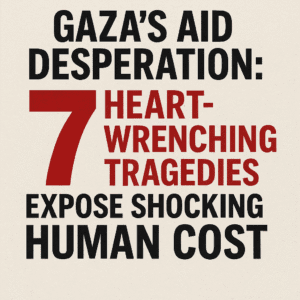Gaza’s Aid Desperation: 7 Heart-Wrenching Tragedies Expose Shocking Human Cost
A deadly incident near a Rafah aid center claimed at least 31 Palestinian lives, with another 132 wounded, marking the deadliest day for a local Red Cross hospital. Survivors and medics described victims shot in the head and chest while seeking food, labeling aid points “centres of mass death.” The Israeli military acknowledged firing “warning shots” nearby but denied causing casualties. Heartbreakingly, one mother shared how her 17-year-old son was killed fetching flour after vowing, “Even if it kills me, I will get you flour.”
Simultaneously, Israeli strikes killed at least 28 more Palestinians across Gaza, including children. In the occupied West Bank, a 20-year-old Palestinian-American man was beaten to death during settler clashes. This crushing reality underscores the agonizing choice Gazans face daily: risk death for sustenance or succumb to starvation, amid stalled ceasefire talks and escalating violence.

Gaza’s Aid Desperation: 7 Heart-Wrenching Tragedies Expose Shocking Human Cost
Beyond the Headlines: The Human Cost of Gaza’s Aid Desperation
The tragedy near a Rafah aid distribution center this weekend lays bare the agonizing reality for Gaza’s civilians: the quest for survival has become a deadly gamble. As conflicting narratives emerge, the human stories cut through the noise.
The Incident: Conflicting Realities Collide
- Red Cross Field Hospital: Reported 31 fatalities and 132 wounded – its deadliest day since operations began. Medical staff describe “overwhelming” gunshot wounds to heads and chests among those seeking food.
- Israeli Military (IDF): Acknowledges firing “warning shots” at figures deemed threatening “hundreds of metres” from the aid site, denying awareness of injuries caused by their actions.
- On the Ground: Paramedic Hassan Omran labeled aid centers “centres of mass death,” alleging deliberate targeting. The US/Israeli-backed aid group GHF operating the site denied any incident occurred nearby, blaming Hamas for “lies.”
A Mother’s Unbearable Loss Somia Alshaar’s voice carries the crushing weight of this conflict. She sent her 17-year-old son, Nasir, for tahini and flour – basic staples. His final words haunt her: “Even if it kills me, I will get you flour.” He returned with a fatal gunshot wound to the chest. Her story isn’t just a statistic; it’s the daily terror faced by families relying on aid points for survival.
The Systemic Crisis This incident isn’t isolated. The Red Cross notes over 250 fatalities and 3,400 weapon-related injuries at food distribution sites since late May. Context is critical:
- Famine Conditions: Israel’s near-total siege has collapsed Gaza’s food system, making aid distribution points literal lifelines – and de facto death traps.
- The Fog of War: Chronic security fears (Hamas infiltration, crowd crushes, Israeli warnings) create impossible conditions for safe aid delivery.
- Eroding Trust: GHF’s swift denial versus eyewitness medical reports highlights the deep credibility chasm hindering humanitarian efforts.
Broader Violence Continues Simultaneously, Israeli strikes killed at least 28 Palestinians across Gaza:
- Deir al Balah: 13 dead, including 4 children and 2 women, after strikes pounded the central region.
- Khan Younis: 15 fatalities reported following airstrikes.
West Bank: A Separate Tragedy In the occupied West Bank, 20-year-old Palestinian-American Sayafollah Musallet was beaten to death during a settler-Palestinian clash in Sinjil. His family demands a US investigation. The IDF cited Palestinians throwing rocks at Israelis as the trigger.
The Stalemate Endures Despite US President Trump’s claims of nearing a ceasefire, talks with Israeli PM Netanyahu show no breakthrough. The grim metrics persist:
- Hostages: Hamas holds ~50 hostages; fewer than half believed alive.
- Palestinian Deaths: Gaza Health Ministry reports over 57,000 killed (majority women/children), though combatant status isn’t distinguished.
The Unanswered Question When survival requires braving potential gunfire for flour, what does “humanitarian aid” truly mean? Nasir Alshaar’s sacrifice for his family’s next meal embodies the catastrophic failure to protect civilians caught between war and starvation. Until safe, unimpeded aid access is guaranteed, Gaza’s aid points will remain symbols of both hope and profound peril. The world watches as the most vulnerable pay the highest price for necessities most take for granted.
You must be logged in to post a comment.